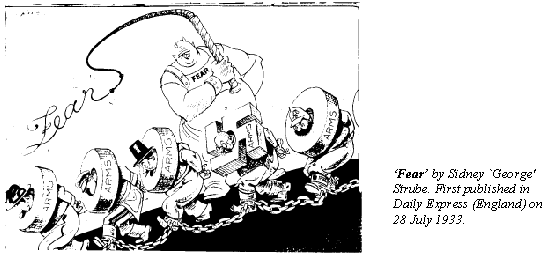|
1 Look at the cartoon, and then answer the
questions which follow.

(a) Describe the main events from October 1929 to
January 1933 that resulted in Hitler’s appointment as Chancellor of
Germany. [5] Answer
(b) How was Hitler able to consolidate his
power in 1933-34? [7] Answer
(c) Did Hitler become a dictator through legal
means? Explain your answer. [8] Answer
Suggested Answers
Question 1a
Remember this ‘5 mark’ question requires you to
describe only. It tests your ability to remember and select relevant
facts. Remember that flow-diagram we designed to show how Hitler became
Chancellor? (see also Grey and Little 33-5)
The first event you need to mention is the economic depression
that resulted from the Wall Street Crash of October 1929 and the
consequences on German society (unemployment 6m by 1932). Next you need
to recognise the Nazi’s electoral success (12 seats in 1928, 230 seats
in July 1932) reasons for this success (propaganda exploited peoples’
desperation) and the pressure this put on President Hindenburg to
appoint Hitler. Finally, you should mention the political crisis and the
failure of Chancellors Heinrich Brüning, von Papen and von Schleicher
to govern. Eventually, in November 1932 the business leader Hjalmar
Schacht and von Papen began to pressure on Hindenburg to do a deal with
Hitler. [Back to questions]
Question 1b
This requires an explanation based on good
historical knowledge. Again we made a revision diagram when we studied
this: ‘Stages in the Nazi Revolution’. Events that might be
described and their significance explained (i.e. how each step increased
Hitler’s power) include: the Reichstag Fire (and Law for the
Protection of People and State), Enabling Act, banning of other
political parties and Trade Unions, abolition of local government, Night
of the Long Knives and Army Oath-Führer. A few dates along the way
wouldn’t go amiss, after all this is a history exam. Most of the table
on page 36 of Grey and Little ‘The Path to Dictatorship’ is probably
worth memorizing. [Back to questions]
Question 1c
This requires a short evaluative essay that
identifies two sides of the argument before reaching a conclusion. To
some extent the route to dictatorship was legal: election success was
based on genuine popular support (evidence?) and the propaganda
strategies of Goebbels were not illegal. The consolidation of power in
1933-4 (Q2) was usually accompanied by legislation to make the actions
legitimate (legal) e.g. the Enabling Law of March 1933. The Weimar
constitution’s Article 48 even allowed for dictatorship in times of
crisis. However, to suggest all the strategies used by the Nazis in this
period were a normal part of constitutional government is clearly
unacceptable. Evidence for this counter argument will centre on the
level of political violence initiated by the Nazis and in particular the
role of the SA in making people afraid to protest. The cartoon stimulus
source ‘fear’ is worth mentioning here.
The Enabling Act vote is a very good example of how the SA
intimidated opponents and recent evidence suggests that the Reichstag
fire was probably part of a Nazi plot. Deals done with the political and
business elites might be an alternative approach, focusing as they do on
secret negotiations that were nothing to do with legitimate political
processes. [Back to questions]
|